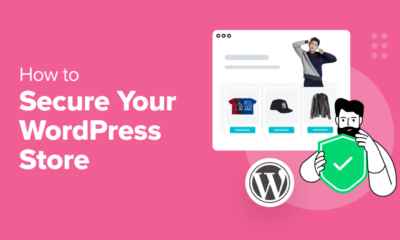MARKETING
Business Growth – The Ultimate Way to Scale Your Business

Every business seeks, in some way or another, business growth through time and expansion to improve its financial, economic and recognition situation in a market that becomes more competitive every day.
This growth is conditioned by many factors or elements that achieve this goal.
There is no magic formula to achieve the expansion of your business. It does not matter if you are a large or small company owner.
The dedication, desire and determination to meet this goal can help you achieve it.
You often think that it is a very distant challenge to achieve and that your company is not in the best situation to do it, but it is not like that!
Read on to learn all about business growth and how, little by little, it can help you fulfill the dream of expanding your business.
Business Growth: What Is It?
This concept generally relates to the evolution and development that businesses go through throughout time, such as ongoing improvement, increasing profitability, attaining goals, improved brand positioning, etc.
Normally, companies grow when they discover a greater demand than they can cover, and they need to broaden their horizons to reach those customers who demand the product or service.
Therefore, it resorts to investing in resources to cover this demand, such as infrastructure, machinery, and production.
What represents the first step to growth.
But business growth does not refer only to this. But it is also about improving your services, especially when it comes to customer service, and how is this achieved?
The training and constant teaching of employees will improve management and generate greater productivity and efficiency to expand your opportunities.
Certain indicators can show you if your company is growing:
- Need to hire more staff, because the one you have is no longer enough
- Greater recognition in the market
- An increase in the flow of customers and, therefore, sales
- Faster product rotation, that is, more is sold than before
- You see yourself in the scenario of having to create more attention channels because the ones you have are not enough
- Among others.
Sometimes no matter how small the change may be, it can reflect that you are facing a panorama of business growth, and you have not even noticed it.
How To Make A Growth Plan?
First, you have to know what exactly a growth plan is?
It is a document containing each of the company’s objectives and all those strategies that you plan to implement to meet them.
The objective is to establish a set of steps to follow that may be changed along the journey and tailored to the conditions that may arise or that in some way obstruct the goal’s achievement.
Let’s have a look at how to make an effective business growth plan.

1. Conduct A Thorough Analysis Of Your Business.
To start making your plan, you must identify each of the elements that are part of your company, including weaknesses, strengths, opportunities and threats that may arise.
Customers, the market, and the competition – are all external factors that can influence or intervene in achieving objectives.
This way, you will be able to see exactly:
- Where do you need to improve?
- Where is it weakest?
- What are the problems you face?
- What is the strong point of the company?
- What opportunities do you have?
With this clear, you will have a starting point to start your growth plan by knowing where you want to go and not starting without a clear premise from the beginning.
2. Set A Budgets
The financial and economic issue is crucial at this stage, so you must establish what your company can really spend to achieve expansion or growth.
Being realistic is very important in this step since you must make sure you have all the necessary resources to achieve the objectives and goals you are setting.
Include each expense that you think may arise.
Therefore, you’ll have a clear picture, or at least a close approximation, of whether you can take on this risk or whether you’ll need to seek outside funding to do so.
The idea is not to have to limit yourself by money; to grow, you need investment. Otherwise, you will always be postponing it.
3. Marketing And Sales Actions
Now that you know what the objectives are and how much you need to achieve them, it is time to define several important points, such as:
- Which clients are the objectives directed to?
- How will you publicize the new product or service?
- What type of advertising will you use?
- How are the market and the competition?
- How will you distribute it if you provide the shipping service?
- Can you include any other sales channel?
You can successfully answer any questions if you implement actions related to digital marketing in your growth plan.
When developing a website, keep everything to the point, including web hosting, web design, intuitiveness, loading speed, responsiveness, and so on.
Social networks are a great ally to achieving many of these objectives, so you must include them in the action plan for growth.
The goal is to reach as many people as possible and give you recognition.

4. Decide A Work Team
In the business growth plan, it is good to include the continuous improvement of your staff or work team.
This will be a crucial factor for them to grow together with your company.
If you are looking to grow, you cannot leave anyone out and having a prepared team focused on developing their skills and being more efficient will help you along the way.
In addition, they may then be able to guide new employees you need to hire due to growth.
Likewise, it defines the processes and actions to improve them so that the management of your company is increasingly compelling.
You will achieve everything with the help of each one of them, that each one specializes in their area and generates better results for you.
The 5 Stages Of Business Growth
Those who run businesses know that the path a small business must take to become a large one is filled with many challenges and opportunities.
Knowing the stages a growing business goes through will give you an edge in making smart decisions at each of these phases.
First Stage: Existence
This is where most companies start, the main priority at this stage is to sell the products or services offered to customers.
This stage is characterized by the fact that the founders or owners are the ones in charge of the entire operation of the business.

Second Stage: Survival
At this stage, the business is already considered viable, it has customers who generate income to keep the company afloat.
Now that the business is growing, the entrepreneur needs to start hiring staff and making strategic alliances, which are key to driving the growth of the company.

Third Stage: Business Success
In this stage of growth, the work of the owners is more of supervision, since now their functions must be more focused on strategic planning and not on micromanagement.

Fourth Stage: Takeoff
This stage is perhaps the most exciting!
If you decide to invest in growth in Stage 3, you want to keep up that pace of investment here, as your business will be entering a phase of rapid growth that you should be very cautious about.

Fifth Stage: Maturity
This is the final stage of the model, but a company’s journey never ends.
You should take advantage of many opportunities here.
The company enjoys stability and resources to maintain its consolidation in the market.

Foundations For A Successful Business Growth Strategy
The growth of a company must be constant.
Not because you have reached the goals in a certain period, you will lower your guard and let the sales be lost for another period.
We must constantly update and improve the goals that we set for ourselves. For this, we will show you what steps you should not neglect:

Focus: what do you want to do? Where do you want to go?
Here we refer to the vision and mission of the company.
Of course, in a growth strategy, the main thing is sales and generating income, but having a clear focus will help you align your efforts.
Culture: we must adapt to the current situation and change for the better.
For example, if we need to invest in new technologies to improve our processes, people must be willing to change positively.
Processes: they must improve as the company grows, producing more and improving your customer acquisition, sales, and loyalty processes.
Infrastructure: If we achieve growth in sales and, therefore, growth in our company, our organizational structure will automatically grow.
People: As we already mentioned, when a company grows, its list of collaborators increases, which it will need to ensure the quality of the processes.
However, successful growth will also depend on people’s commitment to the company.
What Does A Company Need To Grow?

We’ve covered how the most effective method for a company to expand is to increase sales.
However, we need to do more than just increase sales; we need to increase quality sales so that our customers have a unique experience throughout the whole process of enjoying the product or service.To get the experience from customers, we can use user feedback tools. It offers idea boards and feedback widgets allowing your customers to suggest ways to improve product quality and performance.
Let’s see below what elements a company needs to grow.
Products Or Services
It is the basis of your business, it is what you offer and what your company’s income is generated by.
Focus on developing products and services that solve problems that your customers usually have, and describe how your product or service helps solve these problems, this is called a value proposition.
In this way, you will achieve that people connect emotionally and rationally with your company.
Customers
Once we have our product and value proposition defined, selling it would be the next step, but not for this reason, we are going to go out and sell to everyone.
Our product or service is not for all people or companies.
Focus on discovering who is a good client for your company and what characteristics they have.
A good practice that you can carry out here is developing the famous Buyer Personas.
Sales Teams
Now that you have defined your products or services and you know very well who the right customers are, you will realize that your products do not sell themselves.
As we said above, having a sales force is very important for a company to be able to sell its products or services.

Key Factors That Will Determine The Growth Of Your Business
As we have previously mentioned, a company cannot grow if its internal departments work in isolation and without articulation.
Therefore, to achieve the growth of a company , the following elements must be kept synchronized in an organization:

Processes In The Company
For a company to grow profitably, it is very important to define processes and identify those keys to developing its activities.
Without these, it will be difficult for our value proposition to be transmitted by our products or services to the customer.
Qualified People
For processes to work efficiently in a company, qualified people must be available in each area.
It is important to invest in training programs so that people can do their jobs better.
Technology
The digital age has made it easier for companies of any size to use appropriate technologies.
This allows companies to have a competitive advantage by improving the productivity of their processes, which is reflected in more satisfied customers, increased sales profitability.
Growth Strategies
When a business needs to grow aggressively, it likely needs strategies that deliver that growth in a scalable and profitable manner.
Analyze Your Market More Thoroughly
Prior to considering expansion, it’s a good idea to implement growth methods capable of penetrating the market in which your product is sold.
You may gradually establish yourself as a leading brand synonymous with quality, service, and attention.
The idea is to attract new customers within the same niche and get your regular customers to keep coming back to you against the competition. The same you can achieve if you work to increase your website traffic by different means.
You can apply different promotions, offers, loyalty systems and much more.
You can also expand your sales methods, either selling online, offering offices or any other addition that adds value to your service or product.
Create New Products
You can expand your product catalog by creating new options that you can offer your customers, such as alternative, cheaper lines —without losing quality— or even compliment your already offered products.
You can also add new elements according to the seasons to diversify a bit so as not to lose the interest of customers or even improve the product each time.
Always try to maintain your essence and prevent them from getting bored of what you sell.
Optimize Your Resources
A good way to achieve the growth you’ve been waiting for is to look for ways to increase productivity, reduce costs and improve processes.
The optimization of resources will give you the possibility of achieving more sales, generating more income and, at the same time, obtaining better results.
Every time you manage to reduce production times, make sales or reach a goal, the chances you have of being prepared for growth are greater.
Create A Customer Segmentation
Sometimes as a business owner, you may think that you can reach all types of clients, and although it would be very good to achieve it, you must bear in mind that the desired reach is not always achieved.
So you have to focus your strategies on a specific customer segment that is really interested in your product or service.
In this way, they will be more likely to acquire it.
If you manage to establish your ideal client’s profile, it is easier to direct the strategies for them and not only reach a small number of people by using techniques that do not correspond.
Likewise, this will allow you to create a community of customers loyal to your product due to the need or interests they demonstrate.
Expand Your Market
When you already have a good position in your current market, you can try new horizons, either by including products that cover new needs or by expanding your geographical reach.
So that you can put it into practice, you must study how this situation could impact both the company and the clients, making projections or estimates and really studying if you think you can reach this new market.
Drive Growth With Inbound Marketing
Changes in customer purchasing habits are forcing companies to implement new strategies focused on making the consumer experience more valuable.
Today we live in a world where we all need to buy, but nobody wants to be sold to . This is where the methodology that we will talk about makes sense.
Inbound Marketing is a methodology that proposes to sell in a different way through attraction marketing.
Instead of your company going out to chase customers, they are the ones who find you on the internet when They look for informative content.
In this way you will be adding value to the experience of your customers throughout their purchase process.
This methodology was developed by Hubspot and is implemented throughout 4 phases to achieve the growth of your company.

1. Attract prospects and customers to your website: through useful and relevant content that they can find on Google.

2. Convert visitors into contacts: Once they are on your site, they will leave their data in exchange for downloading some premium content (ebooks, guides, templates).

3. Relate and nurture the database: automation technologies automation technologies are used to start a relationship process with a conversational and personalized approach through email.

4. Close with the best-qualified people: Once the technology has helped you in this nurturing and maturation process, you will be able to identify the best-qualified prospects and send them to your sales team so they can close the deal.
When a company uses new technologies, the internet and a growth strategy such as Inbound Marketing, it will be able to:
- Generate more qualified visits to your website
- Increase contacts (leads) and build a database
- Get business opportunities for your sales team
- Have a sales forecast for the coming months
This is what we call a predictable income machine. Having information that allows you to forecast the business’s future income will help you prepare and anticipate the growth of your company in a more intelligent way.
Conclusion
All companies must invest in growth strategies wisely. Preparing for business growth through strategic planning should not be underestimated, as there are risks to unexpected growth.
Finally, the leaders of the organizations must promote the change toward digital transformation so that it is an integral part of the company.
This will allow them to adapt their business models to guarantee their existence in the market and always grow in a profitable and sustained manner.
MARKETING
YouTube Ad Specs, Sizes, and Examples [2024 Update]
![YouTube Ad Specs, Sizes, and Examples [2024 Update] YouTube Ad Specs, Sizes, and Examples](https://articles.entireweb.com/wp-content/uploads/2024/06/YouTube-Ad-Specs-Sizes-and-Examples.jpg)
Introduction
With billions of users each month, YouTube is the world’s second largest search engine and top website for video content. This makes it a great place for advertising. To succeed, advertisers need to follow the correct YouTube ad specifications. These rules help your ad reach more viewers, increasing the chance of gaining new customers and boosting brand awareness.
Types of YouTube Ads
Video Ads
- Description: These play before, during, or after a YouTube video on computers or mobile devices.
- Types:
- In-stream ads: Can be skippable or non-skippable.
- Bumper ads: Non-skippable, short ads that play before, during, or after a video.
Display Ads
- Description: These appear in different spots on YouTube and usually use text or static images.
- Note: YouTube does not support display image ads directly on its app, but these can be targeted to YouTube.com through Google Display Network (GDN).
Companion Banners
- Description: Appears to the right of the YouTube player on desktop.
- Requirement: Must be purchased alongside In-stream ads, Bumper ads, or In-feed ads.
In-feed Ads
- Description: Resemble videos with images, headlines, and text. They link to a public or unlisted YouTube video.
Outstream Ads
- Description: Mobile-only video ads that play outside of YouTube, on websites and apps within the Google video partner network.
Masthead Ads
- Description: Premium, high-visibility banner ads displayed at the top of the YouTube homepage for both desktop and mobile users.
YouTube Ad Specs by Type
Skippable In-stream Video Ads
- Placement: Before, during, or after a YouTube video.
- Resolution:
- Horizontal: 1920 x 1080px
- Vertical: 1080 x 1920px
- Square: 1080 x 1080px
- Aspect Ratio:
- Horizontal: 16:9
- Vertical: 9:16
- Square: 1:1
- Length:
- Awareness: 15-20 seconds
- Consideration: 2-3 minutes
- Action: 15-20 seconds
Non-skippable In-stream Video Ads
- Description: Must be watched completely before the main video.
- Length: 15 seconds (or 20 seconds in certain markets).
- Resolution:
- Horizontal: 1920 x 1080px
- Vertical: 1080 x 1920px
- Square: 1080 x 1080px
- Aspect Ratio:
- Horizontal: 16:9
- Vertical: 9:16
- Square: 1:1
Bumper Ads
- Length: Maximum 6 seconds.
- File Format: MP4, Quicktime, AVI, ASF, Windows Media, or MPEG.
- Resolution:
- Horizontal: 640 x 360px
- Vertical: 480 x 360px
In-feed Ads
- Description: Show alongside YouTube content, like search results or the Home feed.
- Resolution:
- Horizontal: 1920 x 1080px
- Vertical: 1080 x 1920px
- Square: 1080 x 1080px
- Aspect Ratio:
- Horizontal: 16:9
- Square: 1:1
- Length:
- Awareness: 15-20 seconds
- Consideration: 2-3 minutes
- Headline/Description:
- Headline: Up to 2 lines, 40 characters per line
- Description: Up to 2 lines, 35 characters per line
Display Ads
- Description: Static images or animated media that appear on YouTube next to video suggestions, in search results, or on the homepage.
- Image Size: 300×60 pixels.
- File Type: GIF, JPG, PNG.
- File Size: Max 150KB.
- Max Animation Length: 30 seconds.
Outstream Ads
- Description: Mobile-only video ads that appear on websites and apps within the Google video partner network, not on YouTube itself.
- Logo Specs:
- Square: 1:1 (200 x 200px).
- File Type: JPG, GIF, PNG.
- Max Size: 200KB.
Masthead Ads
- Description: High-visibility ads at the top of the YouTube homepage.
- Resolution: 1920 x 1080 or higher.
- File Type: JPG or PNG (without transparency).
Conclusion
YouTube offers a variety of ad formats to reach audiences effectively in 2024. Whether you want to build brand awareness, drive conversions, or target specific demographics, YouTube provides a dynamic platform for your advertising needs. Always follow Google’s advertising policies and the technical ad specs to ensure your ads perform their best. Ready to start using YouTube ads? Contact us today to get started!
MARKETING
Why We Are Always ‘Clicking to Buy’, According to Psychologists

Amazon pillows.
MARKETING
A deeper dive into data, personalization and Copilots

Salesforce launched a collection of new, generative AI-related products at Connections in Chicago this week. They included new Einstein Copilots for marketers and merchants and Einstein Personalization.
To better understand, not only the potential impact of the new products, but the evolving Salesforce architecture, we sat down with Bobby Jania, CMO, Marketing Cloud.
Dig deeper: Salesforce piles on the Einstein Copilots
Salesforce’s evolving architecture
It’s hard to deny that Salesforce likes coming up with new names for platforms and products (what happened to Customer 360?) and this can sometimes make the observer wonder if something is brand new, or old but with a brand new name. In particular, what exactly is Einstein 1 and how is it related to Salesforce Data Cloud?
“Data Cloud is built on the Einstein 1 platform,” Jania explained. “The Einstein 1 platform is our entire Salesforce platform and that includes products like Sales Cloud, Service Cloud — that it includes the original idea of Salesforce not just being in the cloud, but being multi-tenancy.”
Data Cloud — not an acquisition, of course — was built natively on that platform. It was the first product built on Hyperforce, Salesforce’s new cloud infrastructure architecture. “Since Data Cloud was on what we now call the Einstein 1 platform from Day One, it has always natively connected to, and been able to read anything in Sales Cloud, Service Cloud [and so on]. On top of that, we can now bring in, not only structured but unstructured data.”
That’s a significant progression from the position, several years ago, when Salesforce had stitched together a platform around various acquisitions (ExactTarget, for example) that didn’t necessarily talk to each other.
“At times, what we would do is have a kind of behind-the-scenes flow where data from one product could be moved into another product,” said Jania, “but in many of those cases the data would then be in both, whereas now the data is in Data Cloud. Tableau will run natively off Data Cloud; Commerce Cloud, Service Cloud, Marketing Cloud — they’re all going to the same operational customer profile.” They’re not copying the data from Data Cloud, Jania confirmed.
Another thing to know is tit’s possible for Salesforce customers to import their own datasets into Data Cloud. “We wanted to create a federated data model,” said Jania. “If you’re using Snowflake, for example, we more or less virtually sit on your data lake. The value we add is that we will look at all your data and help you form these operational customer profiles.”
Let’s learn more about Einstein Copilot
“Copilot means that I have an assistant with me in the tool where I need to be working that contextually knows what I am trying to do and helps me at every step of the process,” Jania said.
For marketers, this might begin with a campaign brief developed with Copilot’s assistance, the identification of an audience based on the brief, and then the development of email or other content. “What’s really cool is the idea of Einstein Studio where our customers will create actions [for Copilot] that we hadn’t even thought about.”
Here’s a key insight (back to nomenclature). We reported on Copilot for markets, Copilot for merchants, Copilot for shoppers. It turns out, however, that there is just one Copilot, Einstein Copilot, and these are use cases. “There’s just one Copilot, we just add these for a little clarity; we’re going to talk about marketing use cases, about shoppers’ use cases. These are actions for the marketing use cases we built out of the box; you can build your own.”
It’s surely going to take a little time for marketers to learn to work easily with Copilot. “There’s always time for adoption,” Jania agreed. “What is directly connected with this is, this is my ninth Connections and this one has the most hands-on training that I’ve seen since 2014 — and a lot of that is getting people using Data Cloud, using these tools rather than just being given a demo.”
What’s new about Einstein Personalization
Salesforce Einstein has been around since 2016 and many of the use cases seem to have involved personalization in various forms. What’s new?
“Einstein Personalization is a real-time decision engine and it’s going to choose next-best-action, next-best-offer. What is new is that it’s a service now that runs natively on top of Data Cloud.” A lot of real-time decision engines need their own set of data that might actually be a subset of data. “Einstein Personalization is going to look holistically at a customer and recommend a next-best-action that could be natively surfaced in Service Cloud, Sales Cloud or Marketing Cloud.”
Finally, trust
One feature of the presentations at Connections was the reassurance that, although public LLMs like ChatGPT could be selected for application to customer data, none of that data would be retained by the LLMs. Is this just a matter of written agreements? No, not just that, said Jania.
“In the Einstein Trust Layer, all of the data, when it connects to an LLM, runs through our gateway. If there was a prompt that had personally identifiable information — a credit card number, an email address — at a mimum, all that is stripped out. The LLMs do not store the output; we store the output for auditing back in Salesforce. Any output that comes back through our gateway is logged in our system; it runs through a toxicity model; and only at the end do we put PII data back into the answer. There are real pieces beyond a handshake that this data is safe.”
-

 SEO7 days ago
SEO7 days agoGoogle’s Revamped Documentation Shows 4 Reasons To Refresh Content
-
SEARCHENGINES5 days ago
Daily Search Forum Recap: August 26, 2024
-

 SEARCHENGINES7 days ago
SEARCHENGINES7 days agoGoogle Ranking Bug Fixed, August Core Update Swings, AI Overviews, Google Ads Bug & More
-
SEARCHENGINES4 days ago
Daily Search Forum Recap: August 27, 2024
-

 WORDPRESS7 days ago
WORDPRESS7 days agoHow to Secure Your WordPress Store
-

 AFFILIATE MARKETING7 days ago
AFFILIATE MARKETING7 days agoBusiness Owners are Batting 1,000 With This All-in-One Management Hub
-

 SEARCHENGINES6 days ago
SEARCHENGINES6 days agoGoogle Migrating All To Google Merchant Center Next By September
-

 WORDPRESS5 days ago
WORDPRESS5 days ago10 Best StudioPress Alternatives (Genesis Framework)













You must be logged in to post a comment Login